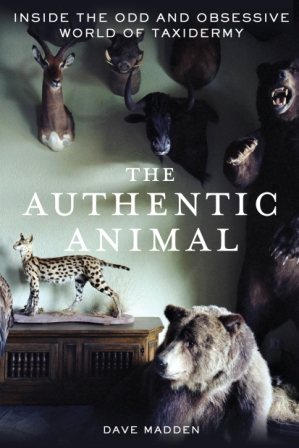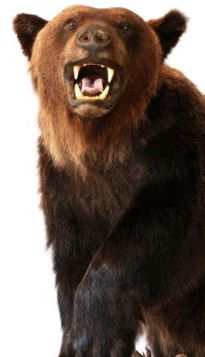
By Dave Madden
From The Authentic Animal
by Dave Madden. Copyright © 2012 by the author and reprinted by
permission of St. Martin’s Griffin, an imprint of St. Martin’s Press,
LLC.
IF THERE'S ANYTHING I've discovered about taxidermy, it’s that people can
have very extreme emotions when it comes to animals. And maybe this is
just as good a place as any to get into the ongoing debates surrounding
animal rights, for by its very nature taxidermy is an affront to those
rights. At least, this is the stance taken by People for the Ethical
Treatment of Animals. “If an animal dies of natural causes,” Colleen
O’Brien, PETA’s director of communications, told me, “PETA would not be
ethically opposed to his or her body being preserved by taxidermy,
although it strikes us as disrespectful to put the animal on display.
We’d never preserve and display a beloved human family member.”
Indeed. PETA’s ethos is a golden rule variant. This is the way taxidermy
is disrespectful—we wouldn’t allow it for one another. All the
taxidermists I’ve talked with, naturally, disagree with PETA. They see
taxidermy as a chief form of respect for animals. Like Wendy
Christensen-Senk, the chief taxidermist at the Milwaukee Public Museum.
Yes, she loves taxidermy, but it cannot compare to the act of bow
hunting elk, her favorite quarry. It’s not what most people think when
they think of hunting. An arrow can go only a fraction of the distance
of a bullet, and so it’s not sitting up in a tree and listening for the
footfalls of something tiny and precious. Elk are animals larger than
most Volkswagens, and when they run it sounds like a fleet of horses at
the finish line, and for Wendy the only way she’s going to come out of
this with a kill is to run right alongside these animals, all of them
bugling their guttural squeals over the thundering of their hooves.
“There is literally nothing more exciting in the world,” she says,
likening it to a religious experience. Of every kind of animal on the
planet Wendy loves the elk the most. She tries to hunt one every year.
Like most contradictions, it’s one we’re uncomfortable with, and that
characterizes what environmental scholar Stephen R. Kellert calls
“nature hunters”: people who love and admire the animals they hunt, who
do it for an “intense involvement with wild animals in their natural
habitats.” Nature hunters are distinguished from utilitarian hunters,
who do it for the meat, and sport hunters, who do it for the mastery and
competition. The nature hunter, more than any other hunter, felt [in
Kellert’s study] the need to rationalize the death of the animal.
Kellert found that most hunters (43.8 percent) were classified as
utilitarian, with sport hunters falling in second place (38.5 percent).
Nature hunters constituted only 17.7 percent of those surveyed. But this
is the demographic that almost every taxidermist I spoke with would
place himself or herself in. For what other reason than affection and
admiration for wildlife would a person become a taxidermist? Certainly
not the money. “I have an extreme love for wildlife,” Wendy says. “I’ve
always had one. When I was young it always bothered me to see animals
all destroyed on the roadside.
Here, then, is a kind of respect for animals. This animal was alive;
then it died. Let’s make it look alive again. One major element of
taxidermy is the way it broadcasts human dominance. We can do this to
animals, but they can’t do this to us, which brings us back to PETA’s
original complaint. The question of course is who gets to decide what’s
best for animals, and what exactly does that entail?
If there’s anyone on the planet best qualified to speak for animals,
it’s the bioethicist Peter Singer, if only because he seems to have
taken the most time to think about it. In his Animal Liberation—the
PETA bible, in many ways—Singer lays out the case for the equal
consideration of animals and the minimizing (if not the end) of animal
suffering. Singer’s approach is rational, not emotional. He admits early
on to not being particularly interested in animals, or even loving
them. He “simply want[s] them treated as the independent sentient beings
that they are, and not as a means to human ends.” Singer smartly avoids
claiming that he knows what’s best for animals. He just knows what’s
bad for humans and humans’ ethical living. “Speciesism” is as ethically
wrong as racism or sexism, and because we would never sit back and allow
suffering on other humans we should also reject the same kinds of
suffering done to animals.
Singer’s focus on suffering is where his ideas begin to overlap with hunting. Rare is the hunter who disregards animal suffering. Rare is the hunter who isn’t concerned for the conservation and proliferation of game. Hunters and animalrights activists have tons of basic, fundamental stuff in common, but what gets broadcast is “meat is murder” and “you’ll pry my gun out of my cold, dead hands.”

I've never felt much fury or even held any mild criticism toward
hunters. I’ve also never understood the impulse. But what have I ever
known about animals? I know that the truth of this world is that our
capacity for love is large enough to allow some room for animals, and
yet this allowance isn’t as warm as our love for other people. It’s
colder, darker, and full of bloodshed. For many people this love has
lots of capacity for cruelty. We keep our dogs in cages throughout the
workday because, we rationalize, they enjoy having a small, tight space
all their own. And when it comes time to sleep at night we do it pretty
soundly. Likewise, many people go out in the wild and find animals to
shoot and kill, and their nights are just as restful. They’re not
monsters. They don’t lack empathetic skills. Moral equivalence isn’t
anything I know much of. But increasingly these days, as I talk to new
kinds of people, it’s getting harder and harder to confidently call
something out when I see it as “wrong” or “immoral.”
Hunting is not taxidermy. The latter can exist without the former. But
more often than not taxidermy is an outcome of hunting, and so it’s
seemed disingenuous to talk so freely about taxidermy without
acknowledging its grisly, ethically murky cousin. If it’s true that
hunting can be (but isn’t necessarily) a way to honor an animal, or that
tangential to the act of hunting is a respect and love for the animal
being hunted, then it follows to me that taxidermy is probably the best
way to broadcast this love to a dubious audience. Because if you shoot a
deer and dress the carcass and butcher the meat to feed your family
through the winter and take the skin and make something of it, isn't
this a form of honor, of deferential respect?
We make icons of our idols, and we have done this since Lascaux. It’s
why self-conscious, eBay’d taxidermy is, in the end, such a drag to find
in people’s houses. An animal had to die for this? To outfit a TV room
with a retro-chic vibe? And I say this as a man who has purchased and
hung self-conscious eBay’d taxidermy. But no longer. Let this be a bit
of advice for anyone looking to get a game head: Don’t just get the
mount, get the story behind the mount. Talk to the hunter and listen to
the steps he took to track down the animal and shoot it. Figure out what
happened to the flesh, the bones, the rest of the skin you’re not
seeing. Maybe it uncomfortably reminds us that this thing we have
decorating our homes had its life taken from it, but more than anything
it keeps taxidermy honest. Every mount is an encounter, a chance to
engage in an animal that would have otherwise been a stranger to you.
It’s why we invented epitaphs: None of us wants to be forgotten in
death. We can’t ever know whether animals feel the same way, but doesn’t
it seem respectful to assume so?
